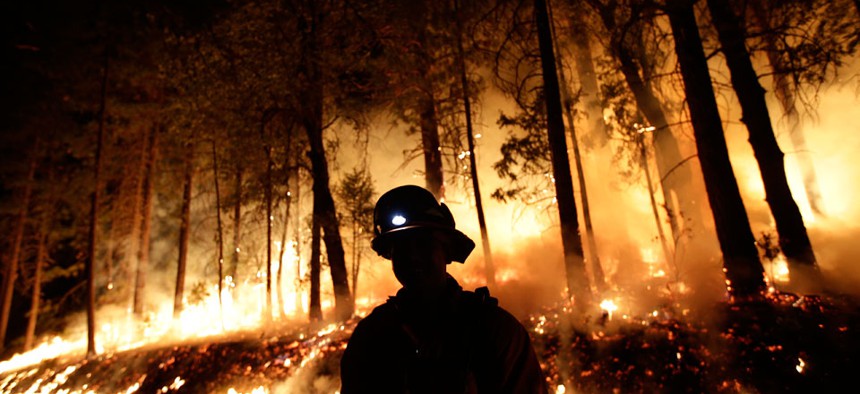Reeling from Sequestration, Forest Service Fights Rim Fire
With firefighting budget dried up, agency faces one of California’s largest ever.
The U.S. Forest Service has taken on a large role in containing and suppressing the wildfire that has burned more than 179,000 acres in Northern California, despite running out of firefighting funds earlier in August.
Part of the Agriculture Department, the Forest Service has deployed more than 500 personnel to help tame the blaze known as the Rim Fire, in addition to millions of dollars in resources. The agency, however, recently announced it had to transfer funds from other Forest Service accounts to cover suppression costs during fire season, with shortfalls mainly due to sequestration.
The automatic budget cuts have forced the Forest Service to hire 500 fewer firefighters this year, according to Bill Dougan, president of the National Federation of Federal Employees. The agency is also down at least 50 fire engines and two planes used to drop fire retardant, he said.
“When you have a large outbreak of fires, as we have seen in the last few weeks, with the reduced resources available, the troops are stretched a lot thinner,” Dougan said.
Budget cuts have also meant a reduction in pre-treatment of forest areas, Dougan said. With less brush cleared, the fires -- such as the current Rim Fire, one of the largest in California’s history -- burn hotter and spread faster.
The Forest Service conducted the “initial attack” on the Rim Fire, according to agency spokesman Mike Ferris, as it started in Stanislaus National Forest. It has since transitioned to an assisting role in the unified command that includes California state firefighters, as well as other federal agencies.
All told, the fire has cost $27.2 million to date, and with the flames only 20 percent contained, that number is expected to grow dramatically, Ferris said. How those expenses are ultimately divided will be sorted out through a cost apportionment agreement, but the Forest Service’s role is far from over.
“We’re in that unified command to the end,” Ferris said.
The Forest Service has been somewhat fortunate, as both the number of fires and acres burned are below 10-year averages. Still, the agency has deferred awarding contracts and grants, placed a moratorium on travel except in emergency situations and limited new hires.
Forest Service Chief Thomas Tidwell told employees that the budgetary shortfalls would certainly have an impact their work. “I realize this direction will have significant effects on the public whom we serve and on our many valuable partners, as well as agency operations, target accomplishments and performance,” he said in a memorandum. “We will strive to reduce these impacts, but we cannot avoid them altogether.”
Looking forward, NFFE is calling on Congress to restore funding to the Forest Service. This will enable the agency to continue fighting fires -- there is still more than a month left in the standard fire season -- as well as refilling the coffers of the accounts it has borrowed from.
“The system for budgeting fire suppression is broken,” Dugan said. “We shouldn’t have to wait until the agencies responsible run out of money. They’re out of money now and where’s Congress? They’re home on vacation.”




